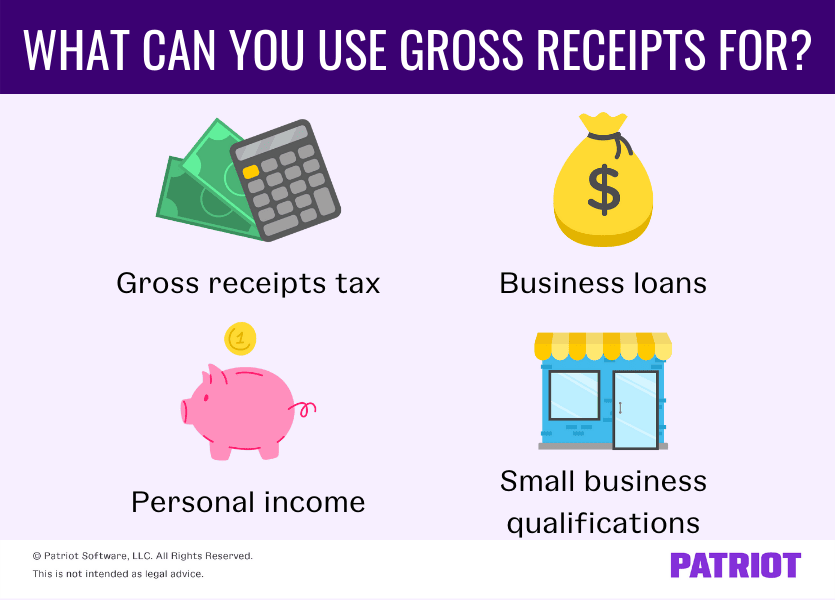At some point or another, you may need to know your gross receipts for certain situations, like taking out a loan. But, what are gross receipts exactly? And, how do you calculate them? Let’s get into the nitty gritty of gross receipts.
What are gross receipts?
Gross receipts include the total amounts your business or organization receives from all sources during its annual accounting period without subtracting expenses or other deductible items. Basically, gross receipts are the total amount of revenue your business collects during the year.
Gross receipts components and rules can vary by state and municipality. To ensure you understand what your state or locality considers gross receipts, consult your state or city.
What can you use gross receipts for?
You may need to find your business’s gross receipts for the period or year for a variety of situations. Here are a few common reasons why you may need to calculate gross receipts:
- Gross receipts tax
- Business loans (e.g., PPP)
- Personal income
- Small business determination and qualifications
Gross receipts tax
Gross receipts tax (GRT) is a tax some businesses in certain states have to pay on gross receipts. To find how much you owe for the tax, you have to look at your total gross receipts for the period.
Gross receipts tax is typically imposed on businesses. However, in some areas, you can impose GRT on consumers at the point of sale.
Some states also impose gross receipts tax in place of corporate income taxes. And, some states impose both corporate and gross receipts taxes.
Overall, whether or not you must pay gross receipts tax varies depending on your business, location, and how much revenue your business generates.
Gross receipts tax can vary from state to state. If your state has a type of gross receipts tax you’re liable for, find your gross receipts to determine your tax liability.
Business loans
You may also need to calculate your gross receipts tax to take out a small business loan.
For example, for the Paycheck Protection Program loans, business owners had to prove that their gross receipts in any 2020 quarter were at least 25% less than their gross receipts in the same 2019 quarter.
Other business loans may also require you to calculate your gross receipts for the current year or previous years. Before taking out a business loan, check to see what kind of information and financial totals you need to provide.
Personal income
When it comes to some business entities, like sole proprietorships, the income passes through the business and onto the owner. In turn, the owner reports it as personal income. And to find said personal income, you need to know gross receipts.
To find your gross receipts for personal income, add up your sales. Then, subtract your cost of goods sold and sales returns and allowances to get total income. The better your financial records are, the easier the process will be.
Small business determination and qualifications
Your gross receipts may also determine whether or not you’re considered to be a small business for certain tax and accounting methods under IRS rules.
For example, if you’re a corporation that has $26 million or less in annual gross receipts for the previous three years and are not a tax shelter, you are generally considered a small business for certain tax purposes.

How to calculate gross receipts
Calculating gross receipts is a straightforward process as long as you know which records to pull and where to find them. To simplify your accounting, you may opt to use accounting software to organize your books and reports for easy access.
Before you do your gross receipts calculation, make sure you:
- Determine the time period you want to measure (e.g., annual gross receipts)
- Find out if your business operates under the cash or accrual accounting method (this will determine when your books recognizes sales and income)
- Gather all receipts and invoices for products or services sold during the period
- Add together all products and services sold from the period to find gross receipts
- Under accrual accounting, only add together sales where you delivered the goods or completed the services during the period
- For cash-basis accounting, only include the sales where you have received payment
Gross receipts example
Say you want to find your gross receipts for the year to take out a small business loan. You sell purses and hats in your store. You sold $45,000 in purses and $30,000 in hats during the year.
To find your gross receipts (sales before any other deductions or expenses), simply add together your sales:
Gross Receipts = $45,000 + $30,000
Your gross receipts for the year are $75,000.
This is not intended as legal advice; for more information, please click here.

